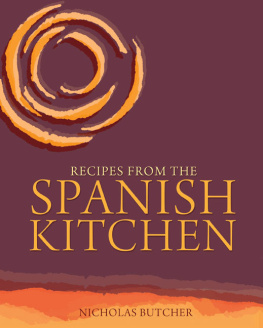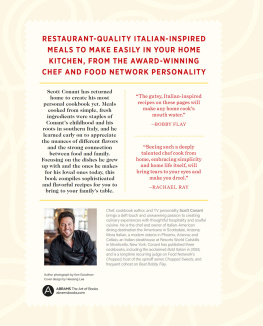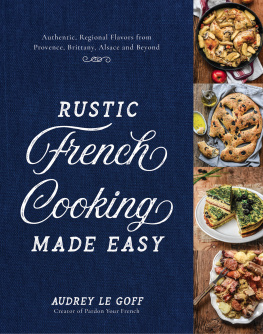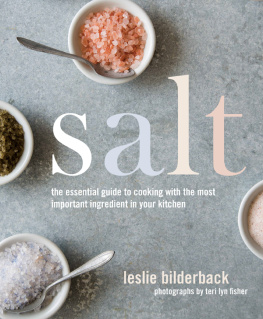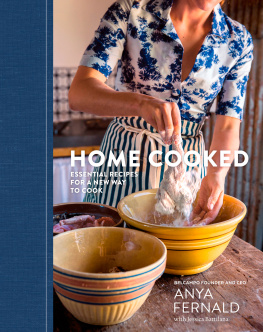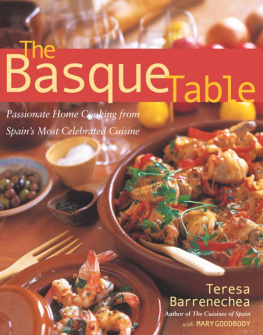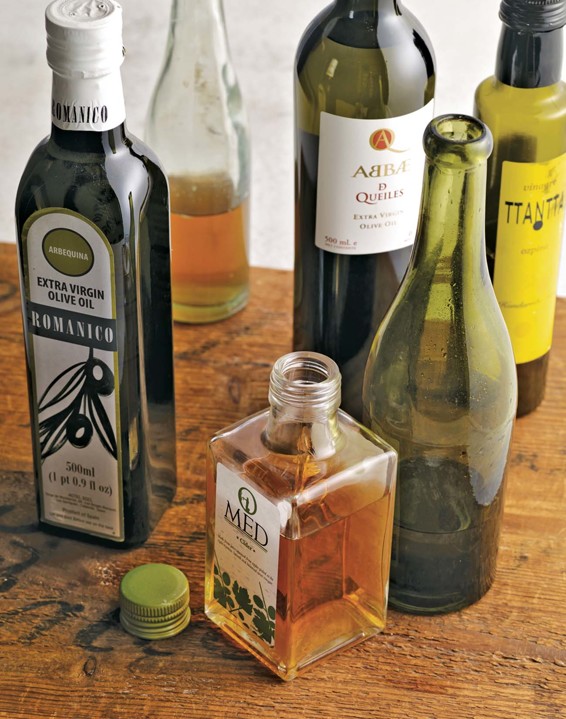ACKNOWLEDGMENTS
To our parents and grandparents for the table, the food-making, and the memory-making. Special thanks to Maria Ins Raij and Bruce Harris: there are no words for our gratitude. Txikito would not be but for the two of you.
Dani Aixela, you are the most positive, food loving, uncynical inspiration to both of us. (And thank you for marrying us!)
To Eders kuadrilla, La Hambrina, thank you for the eternal friendship and fun. To Ernesto Largo and Naiara Pujana, thank you for opening your home and you hearth for this book.
Gracias to all our staff for their hard work and friendship, and especially to Nao, Mivi, Chile, and Dani for their work on the book. We finally have recipes!
Also to Jason Arias for your wisdom and all-around love for this profession; thank you for being there when we could not be, and for making it possible for us enjoy our children.
Mikel Urmeneta, thank you for bringing Txikito to life with your mural and poetry. When you live with a piece of art in your life, day in and day out, it enriches and informs you. Your generous gesture forever changed the restaurant and even the way we see ourselves. Thank you.
Luis Bollo, thank you for introducing us to one another and to the joys of working together.
Carla Raij, Nora Montero, Urtzi Ruiz de Loizaga, Susan Finesman, Jackie Terrebonne, John Willoughby, Anya Von Bremzen, Maricel Presilla, Elena Marsal, Megan Krigbaum, Concha Vecino, Andr Tamers, thank you for being early and constant believers and supporters.
Amy Wilson: thank you for getting it; Robin Raisfeld, Rob Patronite, and Peter Meehan: thank you for getting us. David Chang and Anthony Bourdain, thanks for remembering us when there is so much to remember.
Mark Kurlansky and Emily Lobsenz, thank you for your appreciation for all things euskaldun, for your films, your books, your creativity. We are still learning from you.
Andoni Luis Aduriz and Aitor Basabe, thank you for teaching us how to eat and cook by feeding our souls, our bellies, and our imagination.
Andrew Knowlton, thank you for noticing in the first place and then sticking with the story.
Xavi Sacrist and Rafael Claras: when Catalunya was home to Eder, you taught him how to be and how challenging and satisfying a life in cooking could be. We are still in it because you didnt sugar-coat it.
Ashley Christensen, Mikel Zeberio, Javier Urones, Georgina Aspa, Eduard Llanas, Luis Claramonte, Francis Vega, Fernando Zarauz, Louie Sloves, Juan ngel Vela Del Campo, and Karlos Arguiano: thank you for sharing our love of food, and showing it in all you do.
Fany Gerson, thank you for being an amazing friend and the sweetest person in sweets on the planet. Tu eres Sweet Mexico.
Aaron Wehner, thank you for believing in this book and making Ten Speed Press the most extraordinary home for it, even before it was its home.
Rebecca Flint Marx, thank you for helping us put this story on paper in a way that so honestly speaks to our experience, and your remarkable talent.
Penny De Los Santos, thank you for the fearless and beautiful pictures you took for this book, and everywhere you go.
Thank you to Hannah Rahill for fighting for this book and giving us the most vibrant and amazing talent to make it.
To Emily Timberlake, and Betsy Stromberg, Emma Campion, and Sharon Silva: how did we get so lucky? You are the most amazing editors and designers anyone could hope to have. Thank you for keeping the book so honest and making it so striking. And for being so engaged. You kept the love, beauty, and humor in this humongous effort alive to the very end.
Eskerrik asko!
Alex Raij and Eder Montero
Alex Raij, thank you for letting me be your co-writer and collaborator on what has been an incredible and endlessly thought-provoking journey. And thank you above all for introducing me to the Gilda and forever blowing my mind about the addictive potential of olives, anchovies, and peppers.
Emily Timberlake, our editor extraordinaire: thank you for your patience, thoughtfulness, and impeccable care in turning an ungainly Word document into an honest-to-goodness cookbook; we were so fortunate to be in your capable hands. And a hearty cheers to everyone else at Ten Speed: Hannah Rahill, for believing in the potential of this book; Emma Campion and Betsy Stromberg, for making it such a stone-cold stunner; and Sharon Silva, for your extremely impressive attention to detail.
Penny de los Santos, for bringing the food, people, and landscape of the Basque Country to vibrant and beautiful life.
The family of Eder Montero, for your generous hospitality during our travels.
Rebecca Flint Marx
INGREDIENTS
In most cases, I recommend buying imported Basque or Spanish ingredients, either online or from a specialty store (see ). Imported Basque and Spanish goods are still a tremendous value, just like Basque and Spanish wine. That said, you can also use non-Basque ingredients you love in Basque ways. We always look for the best expression of an item; the quality trumps its provenance. What follows is a list of the most essential Basque pantry items.
Oil and vinegar
At Txikito, we use very few different oils but keep a large variety of vinegars on hand.
ARBEQUINA OLIVE OIL: Arbequina is a common olive cultivar. We use this oil for both cooking and finishing dishes. Were big fans of Romanico, a Catalan brand, and Abbae de Queiles, an organic brand grown on a small estate in Navarra. Both are a bit grassy and have a luscious mouthfeel.
SHERRY VINEGAR: We recommend imported Spanish sherry vinegar, and once you find one with a sweet complexity that you like, stick with it. Be careful that you do not pick up a bottle of cooking sherry, which is an easy mistake to make. (Dont use cooking sherry when I call for manzanilla or fino sherry, either.)
GARNACHA WINE VINEGAR: Not as acidic as sherry vinegar, this is a versatile red wine vinegar of very high quality that is ideal for refritos (seasoned oil-and-vinegar mixtures) that accompany vegetables, fish, and other foods and for many other uses. If you cant find it, substitute another red wine vinegar.
SEASONED RICE VINEGAR: Sweet and relatively mild, rice vinegar is made from fermented rice or rice wine. You can find it in the Asian foods aisle of most supermarkets. We like it for its low acidity and neutral sweetness.
CHAMPAGNE VINEGAR: Although you dont need to spend a lot of money for this vinegar, you do need to buy one thats actually from France. We buy a commodity French brand that is probably the cheapest imported variety available. If you cant find champagne vinegar, Chardonnay vinegar makes a fine substitute. Champagne vinegar is great for making quick pickles or for any dish in which you would typically use cider vinegar.
Chile peppers
Chile peppers appear in numerous Basque dishes; here is a rundown of the varieties used repeatedly in this book.
.
GUAJILLO : Used widely in Mexican cooking, these mild to hot dark red peppers are typically sold dried. In this book, theyre used primarily as a substitute for choricero peppers.


